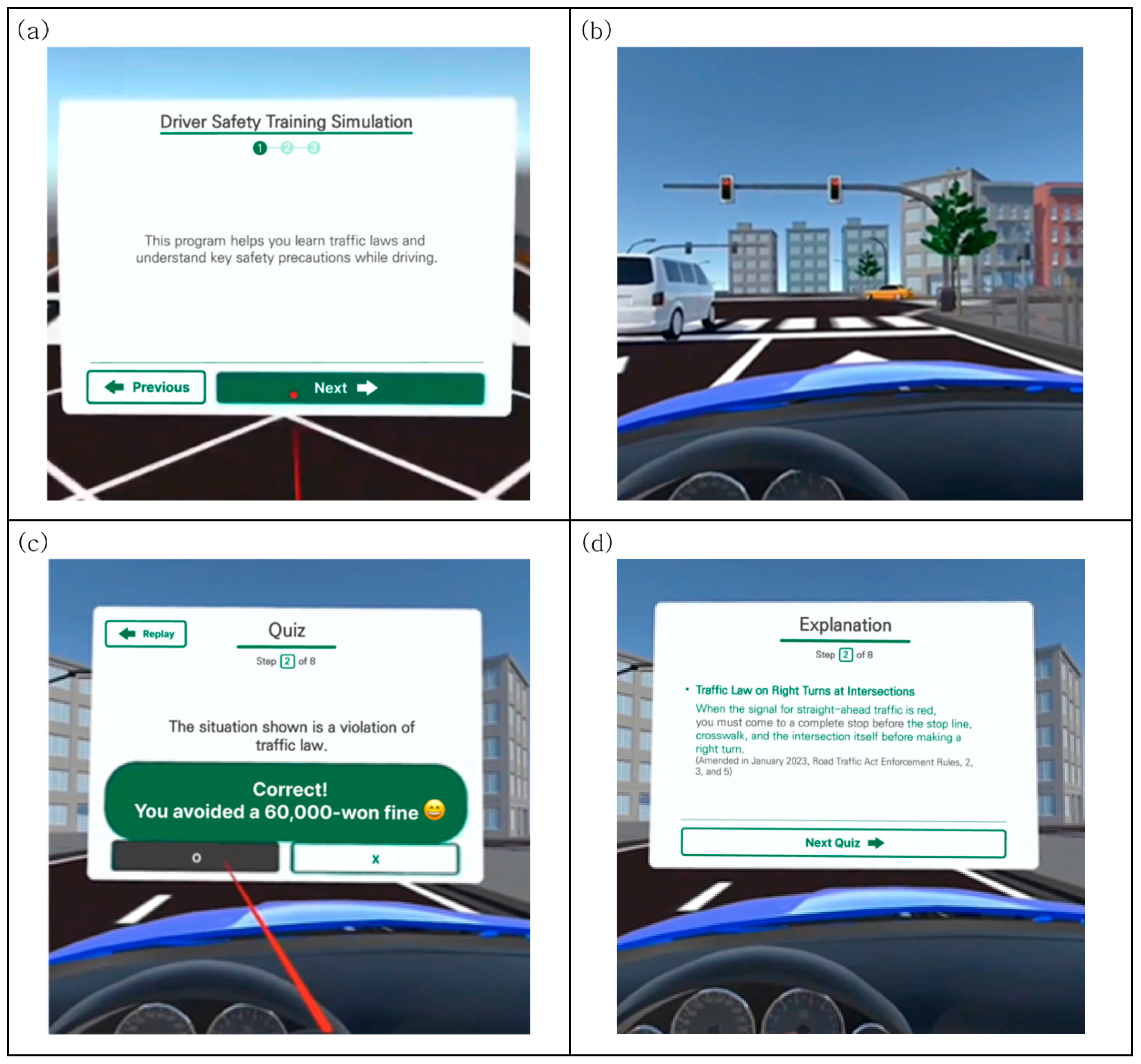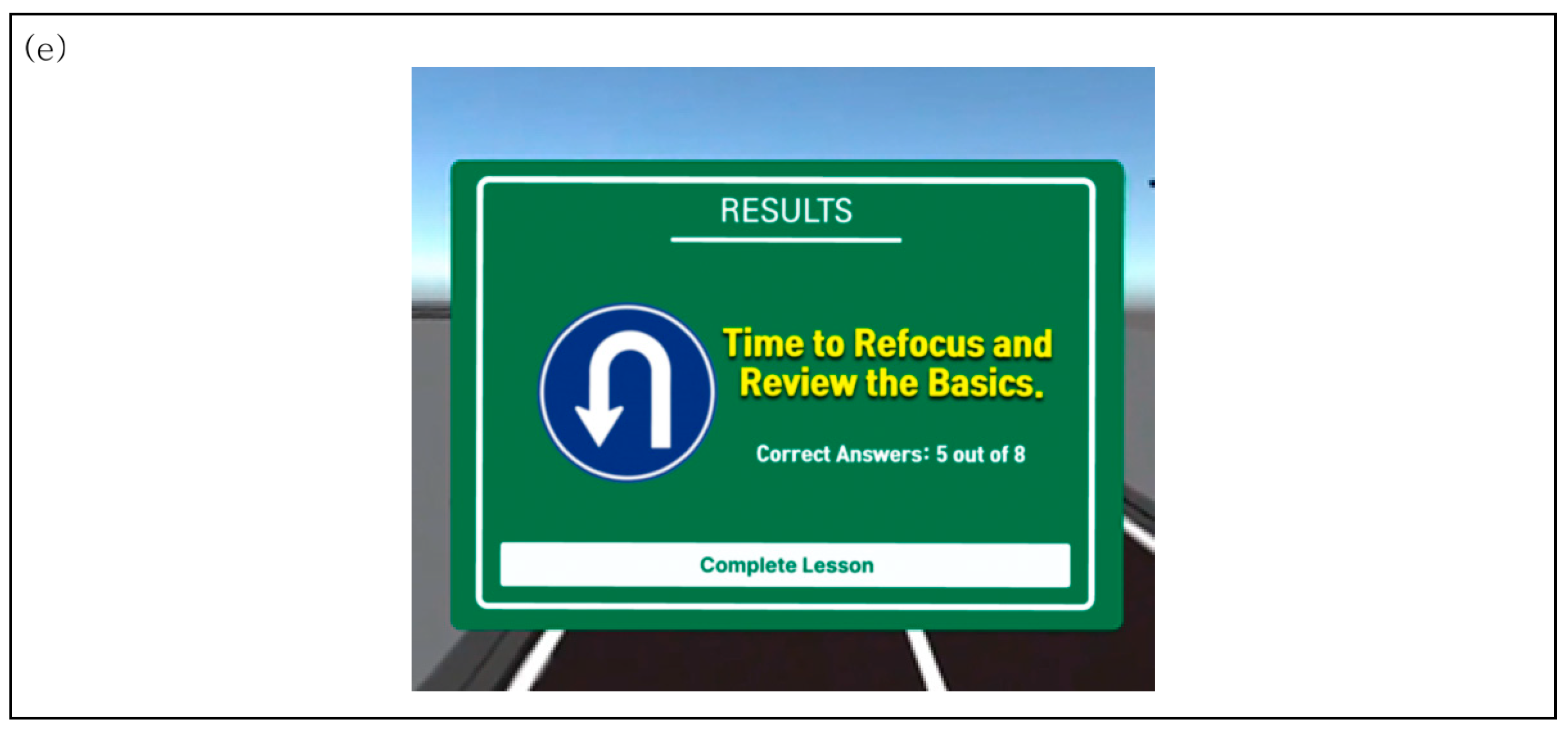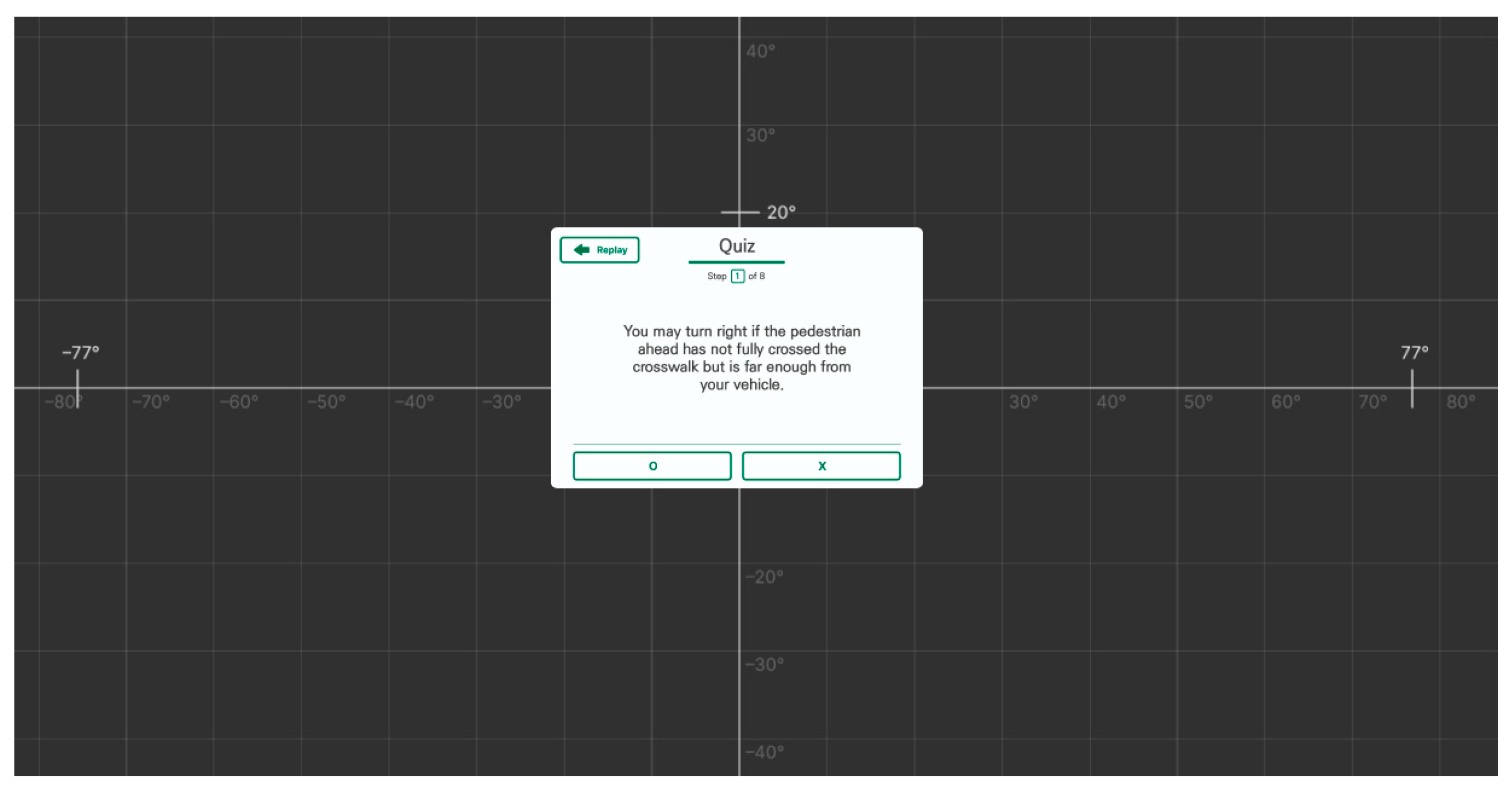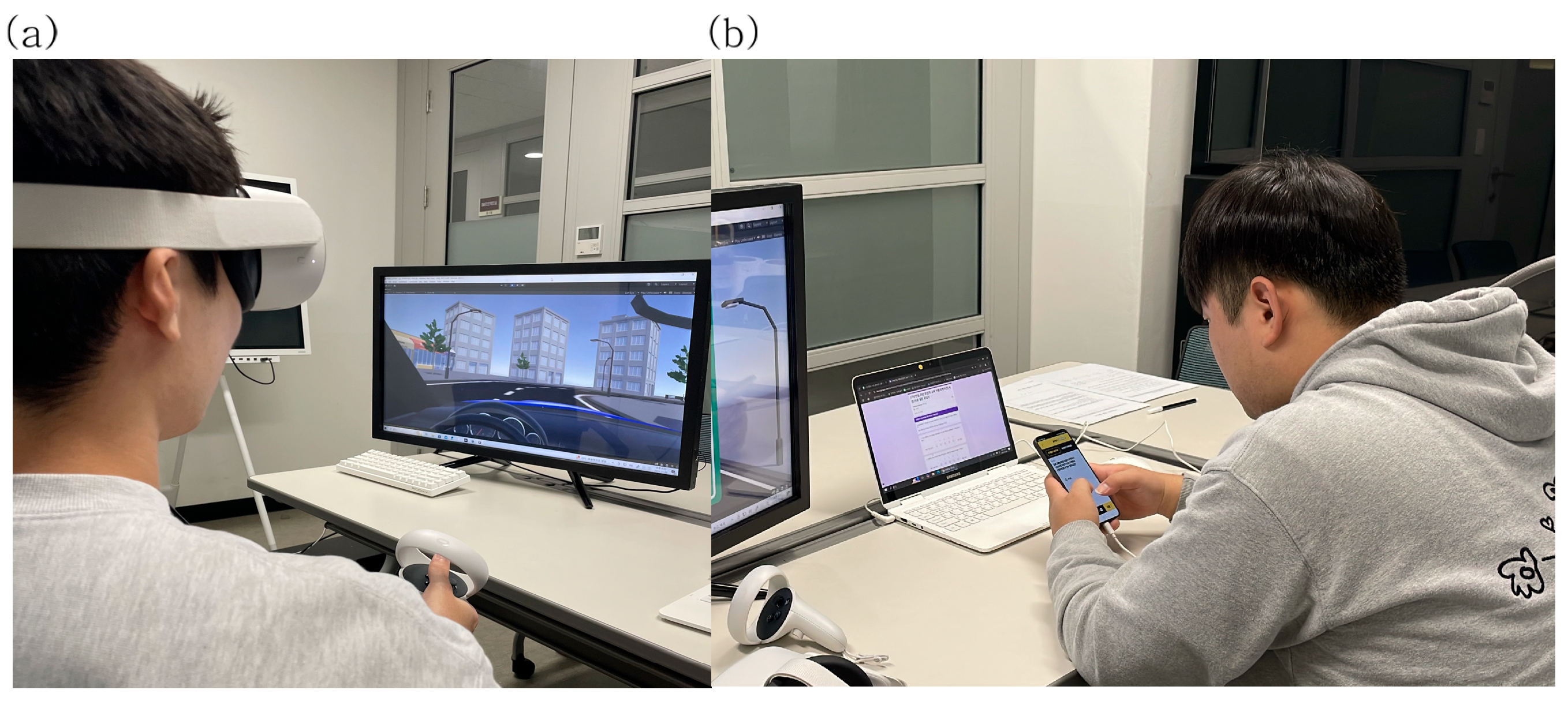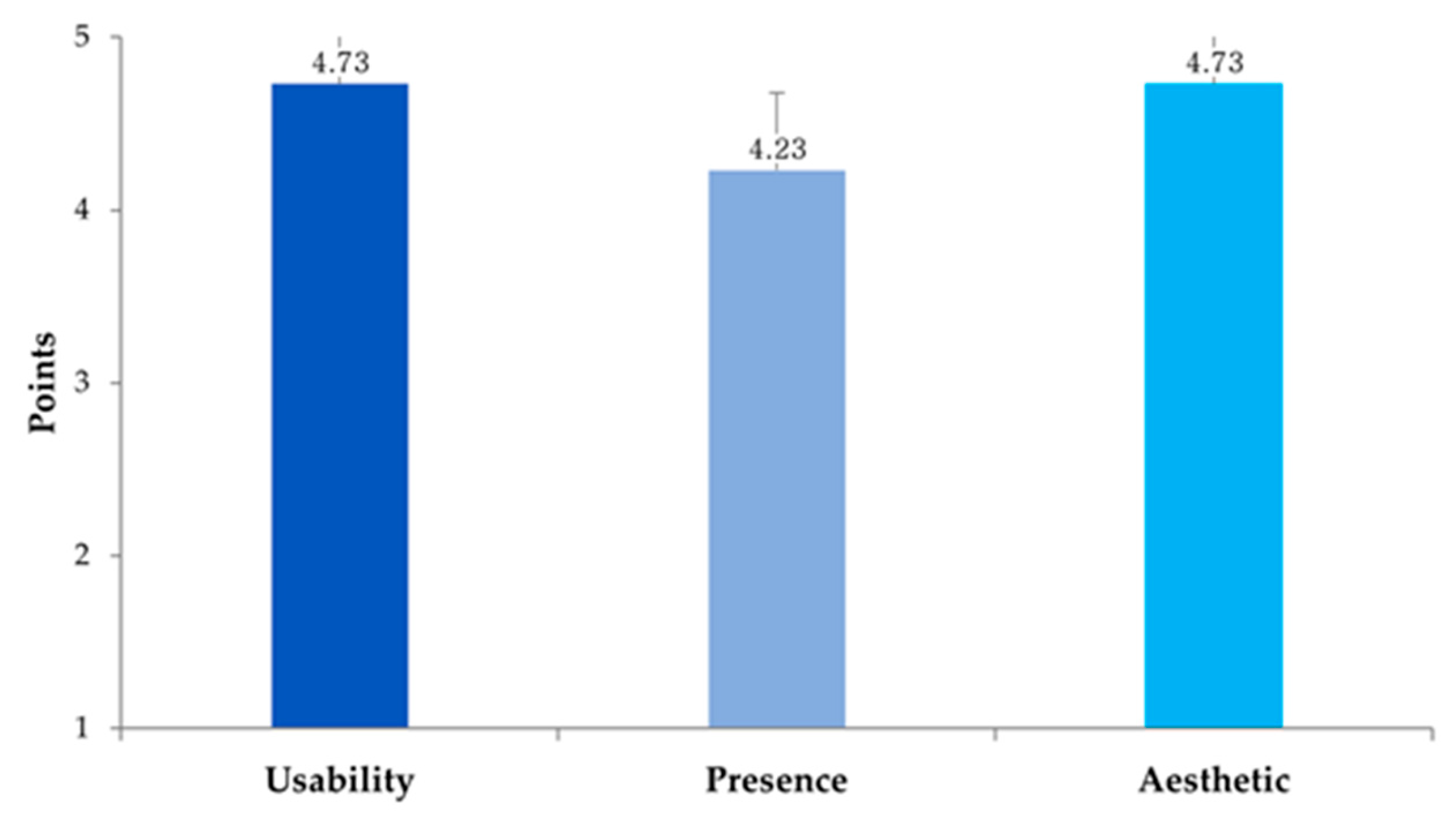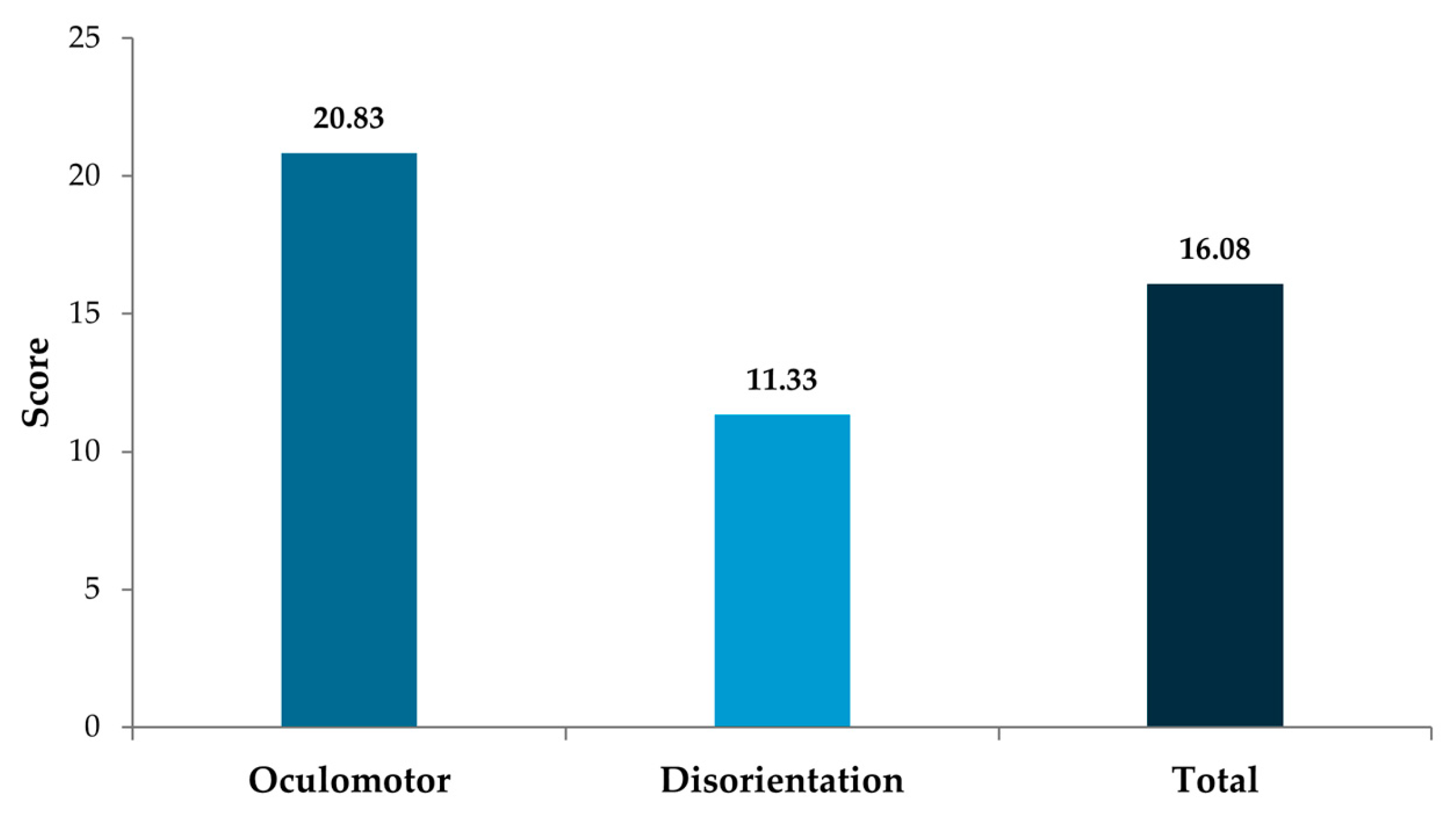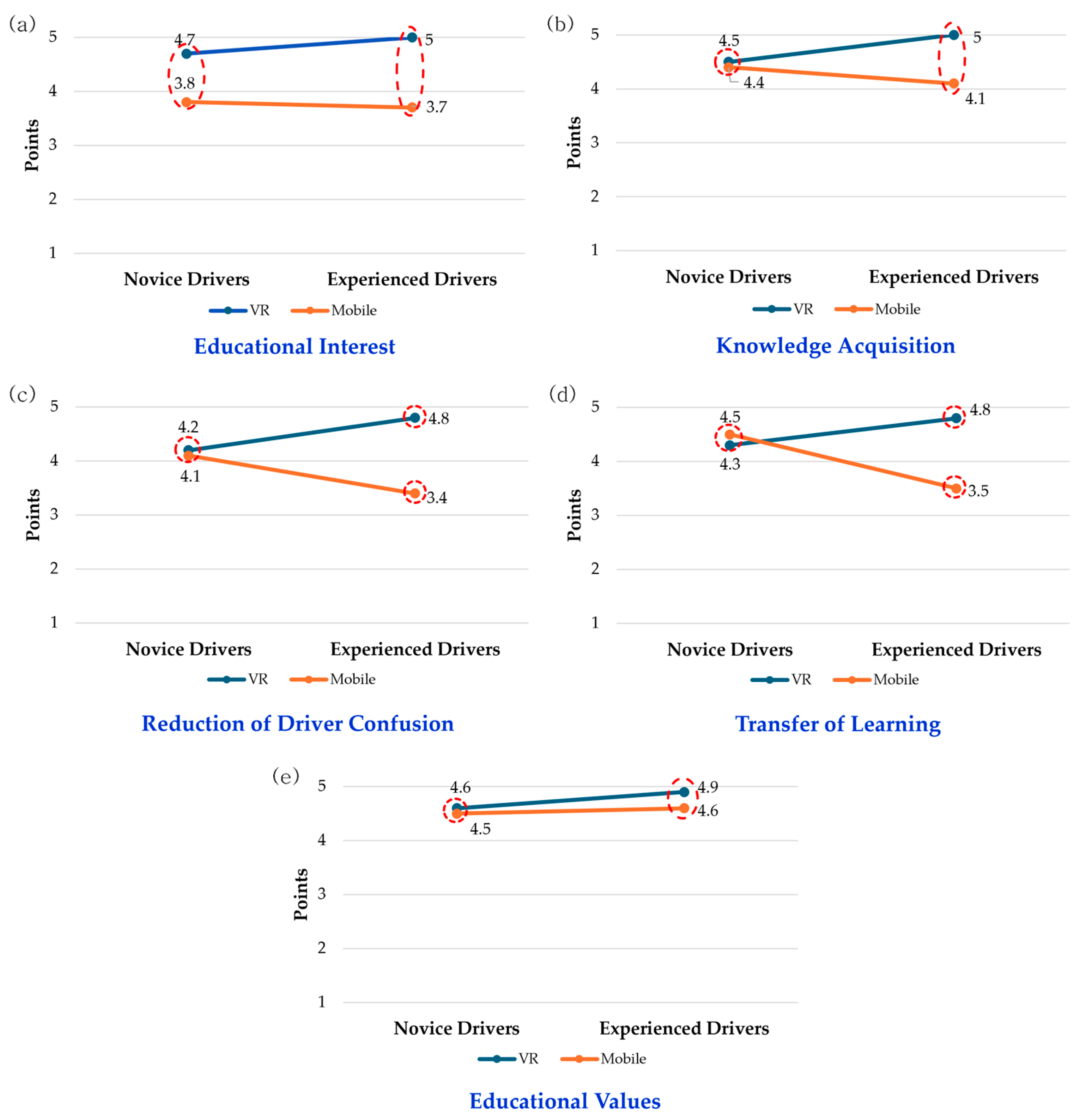1. Introduction
With recent societal changes and technological advancements in South Korea, traffic laws have been frequently revised, making it increasingly challenging for drivers to clearly understand the regulations and stay informed through effective traffic safety education. Faus et al. [
1] reviewed 22 studies on road safety education for adults conducted in Thailand, the United Kingdom, the United States, and Australia, and reported that it is difficult to determine whether such education has a direct impact on reducing accident rates. They emphasized the need for further evaluations to identify more effective educational strategies.
Virtual reality (VR) offers new possibilities for addressing these limitations. Virtual reality (VR) provides realistic visual (visual realism) and auditory elements (auditory realism), allowing users to feel as if they are part of the environment [
2]. These immersive characteristics make VR particularly effective for training cognitive skills and the acquisition of procedural knowledge [
3]. Furthermore, VR simulation could be effectively applied to driver education and training [
4]. Simulation-based training allows users to safely experience complex or hazardous real-world scenarios without actual risk, thereby enhancing understanding and decision-making capabilities [
5]. Therefore, it is essential to explore the development and effectiveness of traffic safety education programs that incorporate advanced technologies such as VR simulation.
Khan et al. [
6] developed a VR-based traffic safety education system and conducted an experiment with ten participants aged 8–15 years to evaluate its learning effectiveness. They found that the VR-based educational program provided greater immersion and improved road safety awareness compared to traditional video- and presentation-based road safety training. Similarly, Gounaridou et al. [
7] created a gamified VR-based traffic safety education program incorporating elements such as scores, badges, and rewards. Their study, involving 20 users aged 8–14 years indicated that gamified VR education was more effective than conventional theory-based education. León-Paredes et al. [
8] developed a VR-based road safety education prototype using traffic accident data from the city of Cuenca. However, their research focused solely on development, and the learning effectiveness of the program was not evaluated. A review of key studies on VR-based traffic safety education shows that while some have demonstrated improved learning outcomes over those of traditional theory-based methods—primarily among children and adolescents—evidence remains limited for actual drivers. Furthermore, limited research exists on comparing the learning outcomes of VR-based education with other digital platforms, such as mobile ones.
The primary goal of traffic safety education is to enhance drivers’ knowledge and understanding of traffic rules and real-world scenarios [
9]. Most VR-based programs focus on increasing accident awareness by providing indirect exposure to hazardous driving situations. Existing programs often fall short in helping learners clearly learn specific traffic laws. Therefore, it is crucial to develop VR-based traffic safety education programs that simulate confusing real-world scenarios but also enable learners to acquire accurate knowledge of traffic regulations—ultimately reducing confusion in actual driving situations.
In this study, we aimed to develop a VR-based driver traffic safety education application to address the limitations of existing programs and assess its usability. We empirically analyzed the learning effectiveness of digital education by comparing the learning effectiveness of VR- and mobile-based traffic safety education. Additionally, we conducted an experiment with participants categorized by driving proficiency to examine the interaction effect between device type and driver expertise on learning outcomes by focusing on the effectiveness of VR-based education. The following hypotheses were developed to be examined in this study:
H1.
The VR-based driver safety training application developed in this study yields significantly higher learning effectiveness than mobile-based traffic safety education.
H2.
The effectiveness of traffic safety education differs based on driving proficiency (experienced and novice drivers).
H3.
There is a significant interaction effect between device type (VR versus mobile) and driving proficiency on learning effectiveness.
2. Literature Review and Analyzing Prior Service
We conducted a literature review on learning effectiveness, usability, and universal design for developing a more effective VR-based driver safety training prototype. Additionally, we analyzed existing VR services to identify their limitations and enhance the distinctiveness of this study.
2.1. Factors of Improving Learning Effectiveness
Learning effectiveness refers to the improvement in a learner’s performance and achievement through engagement with educational media [
10]. Incorporating various elements of educational media can improve learning effectiveness.
Gamification, which increases learning effectiveness and motivation, involves incorporating game elements into non-game contexts, such as learning and work, to engage users [
11,
12]. Subhash and Cudney [
13] reviewed the literature on the effects of gamified learning systems and game elements using higher education learning content in PC and mobile environments. Their findings indicate that elements such as points, badges, and rewards positively impact learners’ motivation and learning effectiveness. Aljezawi and Albashtawy [
14] compared the learning effectiveness of traditional lectures and quiz game-based learning in nursing education and found that the latter led to achievement and persistence. Similarly, Nuci et al. [
15] developed a mobile web-based quiz game application and evaluated its impact on IT-related university courses. They reported that the quiz game approach positively affected learning engagement and performance. Konetes [
16] investigated educational gamification systems in virtual reality (VR) environments by focusing on motivational strategies to enhance learning in educational games and simulations. The study found that virtual educational game simulations enhance learners’ intrinsic motivation.
Lucardie [
17] investigated the impact of fun and enjoyment on learning outcomes in adult education programs. Interviews with 40 adult learners and 9 teachers revealed that these factors enhance learning motivation, concentration, and understanding. Similarly, Webster and Martocchio [
18] demonstrated that the perceived interestingness of educational media positively affects learning achievement and satisfaction.
However, many studies emphasize the importance of effective learning feedback in maintaining a balance between learner engagement and educational objectives in gamified learning systems.
Easterday et al. [
19] compared simple and tutoring-inclusive educational game systems and found that tutoring systems significantly enhance learning outcomes. They also reported that immediate error feedback further improves learning effectiveness. Narciss [
20] evaluated tutoring feedback strategies in digital learning environments and concluded that immediate feedback supports long-term memory retention. Ajogbeje [
21] examined the effects of immediate feedback and found it effective in reducing student confusion and enhancing learning motivation and outcomes.
2.2. VR Considering Usability and Universal Design Aspects
Providing accessible traffic safety education for drivers of various types, regardless of age or disability, is essential for ensuring broad applicability and inclusivity.
A review of prior research on VR user experience confirms that providing tutorials improves usability and learning outcomes. Miguel-Alonso et al. [
22] reported that VR tutorials reduce initial cognitive load and enhance immersion, thereby improving the overall user experience. Kao et al. [
23] examined different types of VR tutorials for learning controller operations and found that tooltips with textual explanations significantly enhanced controller proficiency. Lee et al. [
24] conducted experiments using educational VR games to analyze the impact of tutorial methods on VR game learning effectiveness and user experience of VR games. Both the instruction-screen tutorial (IST) and context-sensitive tutorial (CST) significantly improved learning effectiveness and usability. Users provided with tutorials also experience fewer VR sickness symptoms, suggesting that tutorials are essential for enhancing VR usability.
Regarding interface placement in VR, Alger [
25] recommended placing central interfaces within a comfortable vertical viewing range of −12 to +20 degrees, based on typical head movements. Similarly, Kharoub et al. [
26] emphasized the significance of placing content user interfaces (UIs) within the effective field of view to support accurate and efficient interaction in VR environments.
Universal design is an approach for designing products and environments that are accessible to all users, regardless of age or physical condition [
27]. Lee et al. [
28] reviewed prior research on universal design, created design guidelines for VR shopping malls, and validated them through user experiments. Their results showed that a brightness contrast ratio of 4.5:1 or higher between text and background was satisfactory for both older adults and users in their twenties. They also recommended incorporating visual feedback—such as button hovers or color changes upon selection—to reduce the cognitive burden on users.
2.3. VR-Based Traffic Safety Education Services
VR-based traffic safety education has been developed and commercialized in various forms. Existing services focus on providing indirect experiences of hazardous driving situations and enhancing drivers’ awareness of accidents. Notable examples include Toyota’s TeenDrive365, Avantis Education’s Class VR Road Safety program, and Forward Development’s driving education game City Car Driving.
Launched by Toyota in 2015, TeenDrive365 is a VR simulator that educates drivers about the risks of distracted driving. Users are placed in a simulated Toyota vehicle and, using the Oculus Rift, experience simulations of common distractions such as traffic noise and backseat passengers to understand the dangers of losing focus while driving. Avantis Education’s Class VR Road Safety program aims to improve driving attitudes and reduce traffic accidents by offering users indirect experiences of hazardous driving situations from pedestrian and driver perspectives. Using the Class VR headset, learners can immerse themselves in realistic scenarios that foster awareness of safe driving behaviors. City Car Driving, released in 2007 by Forward Development, is a driving education game that enables users to practice real-world road scenarios, including traffic lights, road layouts, and urban environments. The program is available for a fee and is compatible with the Oculus Rift DK2.
3. Prototype Development
Existing VR-based programs primarily focus on enhancing drivers’ awareness of accident risks by simulating hazardous driving situations. However, existing programs are often ineffective in helping drivers acquire knowledge of traffic regulations and learn how to respond effectively to real-world driving situations. Thus, this study developed a VR-based driver safety training prototype that simulates confusing real-world scenarios while also enabling learners to acquire accurate knowledge of traffic regulations. The prototype was developed based on findings from a literature review identifying factors that enhance learning effectiveness, usability, and universal design principles.
3.1. Prototype Features and Development
This study designed the key features and flowcharts of the prototype (
Table 1) based on literature reviews of factors that improve learning effectiveness (
Section 2.1) and principles usability and universal design in VR (
Section 2.2). Therefore, we developed a VR-based driver safety training education quiz gamification system. The prototype enables users to explore a 360-degree virtual driving environment from a driver perspective, offering an immersive simulation of potentially confusing situations. It also supports effective learning of traffic regulations and improves decision-making through quizzes and explanatory feedback. The prototype was developed using the Unity software (version 2021.3.43f1).
3.2. Prototype Design
Reflecting on the literature review of factors that improve learning effectiveness (
Section 2.1), we designed a quiz-based gamified learning system incorporating engaging elements and an immediate feedback tutoring UI. To design a quiz-type gamified learning system, we developed a quiz UI to increase learner motivation and learning effectiveness. Additionally, to enhance intrinsic motivation through achievement, a strategy known to improve learning effectiveness in educational virtual games—an interface showing that no fines are imposed for correct quiz answers—was designed (
Figure 1c).
To incorporate elements of interest, the final UI presents road traffic-themed visuals after users complete all eight quizzes, with designs varying based on the number of correct answers to enhance engagement (
Figure 1e). Moreover, drawing on prior research demonstrating the benefits of tutoring and immediate feedback, we designed a commentary interface that provides instant correct/incorrect feedback and explanations following each quiz question (
Figure 1d).
This study incorporates usability insights from prior research (
Section 2.2) and partially adopts design guidelines proposed by Lee et al. [
28] to develop a prototype that emphasizes usability and universal aspects. The main design features include creating tutorials to guide the controller and program, central interface placement, high-contrast design, and color-switching design according to button interaction. To reduce the users’ cognitive load, we developed a VR-based driver safety training tutorial and designed a controller tutorial that included photos and tooltips of the VR controller, along with text, to enhance the learning ability of users unfamiliar with the controller.
Moreover, we designed a tutorial to guide the user through the program and improve its usability by reducing the initial cognitive burden on the user (
Figure 1a). Additionally, to minimize motion sickness, we carefully positioned the central interface within a horizontal range of approximately −77° to +77° and a vertical range of −12° and +20° from the center point (
Figure 2).
To ensure universal accessibility, we applied a high-contrast design with a minimum contrast ratio of 4.5:1 across all UI components, including buttons [
29]. For interaction-based feedback, we implemented color changes triggered by user actions, such as hovering and clicking on buttons [
30,
31]. High-contrast measurements confirmed that the quiz UI achieved contrast ratios of 10.53 (white and black) and 5.92 (white and green), whereas the progress indicator UI satisfied contrast ratios of 5.92 (green and white) and 5.19 (green and yellow). The button default and hover states maintained a contrast ratio of 5.92, and the button click state reached 10.53. This UI was designed using Figma, and key screens of the final prototype are shown in
Figure 1.
4. Research Method
This study evaluated and compared the learning effectiveness of a VR-based driver safety education system and a mobile-based educational program. In addition, we analyzed the developed prototype in terms of usability, presence, aesthetics, and sickness.
4.1. Participants
The experiment was conducted with 20 participants (11 men and 9 women), recruited into two groups: novice drivers (n = 10; 6 men, 4 women; M = 24.1, SD = 2.61) and experienced drivers (n = 10; 5 men, 5 women; M = 33.5, SD = 13.63). Novice drivers were defined as individuals who had obtained a driver’s license within the last 2 years or had held a license for over 3 years but had driven less than 10 times. Experienced drivers were defined as individuals who owned a personal vehicle and drove at least three times per week. Participants were recruited online from Kwangwoon University and received a gift certificate worth USD 3 as compensation. All participants were physically healthy, had no difficulty using VR devices, and were capable of completing the experiment. The study was approved by the Institutional Review Board of Kwangwoon University (IRB No. 7001546-202401129-HR(SB)-011-01; Approval Date: 29 November 2024).
4.2. Experimental Environment
The experiment was conducted in a university laboratory using a head-mounted display (HMD), the Oculus Quest 2. Each participant interacted with both the developed VR-based prototype via the Oculus Quest 2 and the mobile-based Driver Safety Education Application using a Galaxy S24 device. The mobile application used in this study was Driver’s License PLUS, an extensively recognized traffic law education app that provides quiz-based learning using text, photos, and videos. It was selected due to its suitability for comparing the usability and learning effectiveness of driver safety education between mobile and VR devices.
During the experiment, the facilitator monitored participants’ behavior using a 32-inch Samsung touch monitor (HDL-T320-OV-IR; Samsung Electronics, Suwon, Republic of Korea) (
Figure 3).
4.3. Questionnaire Item
The questionnaire items used to evaluate the usability and learning effectiveness of the VR-based driver safety training prototype are presented in
Table 2 and
Table 3, respectively. The questionnaire items for usability, presence, aesthetics, and learning effectiveness were designed with reference to prior studies [
32,
33,
34,
35]. The items of sickness were developed based on the virtual reality sickness questionnaire (VRSQ) [
36] and simulator sickness questionnaire (SSQ) [
37].
Among the usability factors, sickness was measured using a 4-point scale ranging from 0 (not at all) to 3 (very). Usability, presence, aesthetics, and learning effectiveness were measured using a 5-point Likert scale, from 1 (strongly disagree) to 5 (strongly agree). The mobile driver safety education application evaluated the same learning effectiveness questionnaire items as the VR-based prototype (
Table 3).
4.4. Experimental
This study compared the learning effectiveness of a VR-based driver safety education system with that of mobile-based educational content. Before the experiment, participants were informed about its purpose and procedures and provided written consent.
Next, participants were briefed on the execution scenarios for each device and received pretraining on how to wear the VR headset and adjust focus. The developed VR-based driver safety education prototype was then used for the main experiment. The prototype’s driving scenarios and quizzes were designed based on an analysis of traffic regulations frequently misunderstood by drivers and written license test items with high incorrect response rates. Sample quiz items are presented in
Table 4. Immediately after using the prototype, participants completed questionnaires assessing usability, simulator sickness (
Table 2), and learning effectiveness (
Table 3).
Next, participants completed a driver safety education session using the mobile application Driver’s License PLUS, which was downloaded from Google Play. This application presents driving scenarios illustrated through text, photos, and videos, and includes eight quizzes on traffic regulations and explanations. Sample quiz items are shown in
Table 4. Participants completed each quiz and reviewed explanations for both correct and incorrect answers to enhance their understanding of traffic laws. After the mobile training session, they completed the learning effectiveness questionnaire (
Table 3).
Finally, after completing both device-based experiments and questionnaires, in-depth interviews were conducted. The entire experimental session lasted approximately 60 min. The VR and mobile experimental sessions were conducted for the same duration of 15 min each. Participants were free to take breaks or withdraw at any time.
4.5. Data Analysis
Descriptive statistics were used to summarize the experimental results. Usability evaluation outcomes for the developed VR-based driver safety training prototype are presented in
Section 4.5.1. Two-way analysis of variance (ANOVA) was conducted to examine differences in learning effectiveness based on device type and driver expertise (
Section 4.5.2). All statistical analyses were performed using the RStudio (version 4.1.3), with the significance level set at α = 0.05.
4.5.1. Usability Analysis of the Developed VR-Based Driver Safety Training Prototype
Among the survey items used to evaluate the usability of the developed VR-based driver traffic safety education prototype (
Table 2), analysis of average scores for usability, presence, aesthetics, and sickness showed high satisfaction across all factors. The usability and aesthetic factors both received the highest average score of 4.73 (SD = 0.51 and SD = 0.45, respectively). The presence factor scored 4.23 points (SD = 0.84) (
Figure 4). The sickness factor, evaluated on a 4-point scale, was calculated using the VRSQ scoring method by Kim et al. [
36] and resulted in a total score of 16.08 (
Figure 5).
4.5.2. Analysis of Learning Effectiveness by Device Type and Driver Expertise
In this study, we conducted ANOVA to examine the differences in learning effectiveness according to device type and driver expertise, as well as their interaction. The device type variable included two levels: VR and mobile. Driver expertise was also categorized into two levels: novice and experienced drivers. Learning effectiveness was measured using survey-based evaluation items (
Table 3).
A two-way ANOVA revealed statistically significant differences by device type in the educational interest (
p < 0.001, α = 0.05) and reduction of driver confusion (
p < 0.05, α = 0.05) according to device type. For both these factors, the VR device scored higher than the mobile device. Knowledge acquisition, transfer of learning, and educational values showed no statistically significant differences in the average user evaluation scores based on device type (
p > 0.05, α = 0.05) or driver expertise (
p > 0.05, α = 0.05) (
Table 5). However, for all three evaluation factors, the average user evaluation score for the VR devices showed higher average evaluation scores than the mobile devices.
Additionally, among the five evaluation factors of learning effectiveness, the interaction effect between device type × driver expertise (
p < 0.05, α = 0.05) was statistically significant for the factors of reduction of driver confusion and transfer of learning (
Table 5). Post hoc analysis within the driver expertise conditions revealed that the score difference between VR and mobile devices for the reduction of driver confusion was significant for experienced drivers (
p = 0.039) but not for novice drivers (
p = 0.766) (
Figure 6c).
Similarly, for the transfer of learning factor, a significant difference in user evaluation scores between devices was found among experienced drivers (
p = 0.022) but not for novice drivers (
p = 0.167), with mobile scoring higher than VR (
Figure 6d). A comparison of novice and experienced drivers on VR devices showed no significant differences in either the reduction of driver confusion (
p = 0.111) or the transfer of learning (
p = 0.177).
5. Discussion
5.1. Usability of the Developed VR-Based Driver Safety Training Prototype
The usability analysis of the developed VR-based driver safety training prototype indicated high satisfaction across all evaluation factors—usability, presence, aesthetics, and sickness—demonstrating the prototype’s overall effectiveness in ensuring user satisfaction. In particular, usability and aesthetics received the highest scores. High satisfaction was recorded regarding usability and aesthetics.
Additionally, in the in-depth interviews for the usability questionnaire item, “The program was easy to use,” participants noted that “the buttons and user interface were easy to identify, and the text was legible, making the program easy to use.” This aligns with Lin’s [
38] findings that high-contrast design improves readability and usability.
Regarding the placement of the central interface placement design, it was noted that “the UI was placed in the center of the field of view, which reduced head rotation, resulting in less dizziness.” This result corresponds to Alger’s research, which found that centrally placed interfaces help alleviate motion sickness [
25].
5.2. Learning Effectiveness by Device Type and Driver Expertise
Among the five learning effectiveness evaluation factors, educational interest and reduction of driver confusion exhibited statistically significant differences between device types (VR and mobile). Regarding educational interest, many participants stated that “learning through VR and quizzes did not feel like rote memorization and was engaging.” This observation is supported by the research of Yang and Goh [
39], indicating that VR simulation improves learners’ motivation. Moreover, this aligns with Harackiewicz et al. [
40], who found that interest in the educational process positively contributes to learning motivation and meaningful learning experiences. Following the in-depth interviews regarding the confusion reduction effect, many participants commented that they were able to clearly understand how to respond to each situation by learning how to respond after experiencing traffic law confusion. This study demonstrated that a VR-based gamified quiz system for driver safety education was more effective than mobile applications in enhancing educational interest and reducing driver confusion. Thus, H1 was partially supported.
Barić et al. [
41] measured the effectiveness of VR-based training in crossing safety education for learner drivers and found that immersive VR technology can contribute to traffic safety and accident prevention. However, this study empirically confirmed the effectiveness of VR-based traffic safety education and compared its learning effectiveness to that of mobile-based education. However, no significant differences were found across the five evaluation factors of learning effectiveness based on driving proficiency. Hence, H2 was not supported.
Statistically significant interaction effects between device type and driver expertise were found for the factors of reduced driver confusion and transfer of learning. Participants in the experienced driver group noted that learning situation-specific responses from an actual driver’s perspective enhanced their understanding of traffic regulations. Conversely, learning only through text and images in a mobile environment could lead to misinterpretation. This suggests that VR-based driver safety education is more effective than mobile education in reducing confusion and in applying it to real driving situations for experienced drivers. However, the interaction effects between device type and driving experience were not statistically significant for educational interest, knowledge acquisition, and educational values. Therefore, H3 was only partially supported.
Krasniuk et al. [
42] evaluated the impact of driving simulator training on driving skills and safety but concluded that the short- and long-term effects of simulators on novice drivers’ short- and long-term effects on real road driving or safety are uncertain. In contrast, our study is significant, as it analyzed the learning effectiveness of VR-based driver safety education for both experienced and novice drivers and empirically validated its positive effect, particularly for experienced drivers.
In summary, the VR-based driver safety training quiz gamification system was more effective than mobile-based education in enhancing learners’ educational interest and reducing during driver confusion. For experienced drivers, it was particularly effective in improving transfer of learning and reducing confusion. VR-based driver safety education is recommended for experienced drivers to reduce driver confusion and facilitate the practical application of learning.
5.3. Limitations
A limitation of this study is the lack of age diversity among participants. The novice driver group consisted solely of individuals in their 20 s, as novice drivers were defined as those who had obtained a driver’s license within the last 2 years or had driven less than 10 times despite holding a license for over 3 years. Future research should recruit participants across various age groups, particularly older adults, to validate the effectiveness of VR-based driver safety education.
Second, the learning effectiveness was assessed solely through subjective rating scales administered immediately after the experiment, without objective knowledge tests or behavioral performance indicators. Moreover, follow-up assessments were not conducted, making it impossible to evaluate the long-term learning effects. In future studies, delayed assessments should be conducted and long-term learning effectiveness should be evaluated using objective indicators, such as the decrease in the number of traffic offenses.
Third, this study was conducted with a small number of participants, with 10 individuals in each group. This indicates that it is difficult to ensure the representativeness of the results. Thus, future studies should recruit more participants to verify the statistical evaluation and generalizability.
6. Conclusions
This study developed a VR-based driver safety training application based on a literature review on VR usability, a universal design, and factors that enhance learning effectiveness. Usability was evaluated for experienced and novice drivers, and learning effectiveness was compared by device type and driver expertise. The results confirmed the high usability of the developed prototype. Additionally, VR-based driver safety education was found to be more effective than mobile-based education in improving learners’ educational interest and reducing driver confusion. For experienced drivers, it also improved the transfer of learning and further reduced confusion.
These findings provide key insights for enhancing the usability and learning effectiveness of VR-based educational content and can contribute to the advancement of digital traffic safety education. In this study, the developed VR-based driver safety training application is expected to provide drivers with accurate information on traffic regulations, reduce driver confusion, and consequently decrease the occurrence of accidents in actual driving situations.
Author Contributions
Conceptualization, H.J. and H.K.K.; methodology, H.J. and H.K.K.; software, H.J.; data analysis, H.J. and H.K.K.; writing—original draft, H.J.; and writing—review and editing, H.K.K. All authors have read and agreed to the published version of the manuscript.
Funding
This research was supported by the Ministry of Science and ICT (MSIT) Korea under the ICAN (ICT Challenge and Advanced Network of HRD) program (IITP-2025-RS-2022–00156215), supervised by the Institute of Information & Communications Technology Planning & Evaluation (IITP). Also, this research was funded by a research grant from Kwangwoon University in 2024.
Institutional Review Board Statement
This study was approved by the IRB of Kwangwoon University (7001546-202401129-HR(SB)-011-01; Approval Date: 29 November 2024), Republic of Korea.
Informed Consent Statement
Informed consent was obtained from all subjects involved in the study.
Data Availability Statement
The original contributions presented in this study are included in the article. Further inquiries can be directed to the corresponding author.
Conflicts of Interest
The authors declare no conflicts of interest.
Correction Statement
This article has been republished with a minor correction to the Funding statement. This change does not affect the scientific content of the article.
Abbreviations
| VR | Virtual Reality |
| ANOVA | Analysis of Variance |
| M | Mean |
| SD | Standard Deviation |
| VRSQ | Virtual Reality Sickness Questionnaire |
| SSQ | Simulator Sickness Questionnaire |
| df | Degree of Freedom |
References
- Faus, M.; Pla, F.A.; Martínez, C.E.; Hernández, S.A.U. Are adult driver education programs effective? A systematic review of evaluations of accident prevention training courses. Int. J. Educ. Psychol. 2023, 12, 62–91. [Google Scholar] [CrossRef]
- Saghafian, M.; Laumann, K.; Akhtar, R.S.; Skogstad, M.R. The evaluation of virtual reality fire extinguisher training. Front. Psychol. 2020, 11, 593466. [Google Scholar] [CrossRef]
- Renganayagalu, S.K.; Mallam, S.C.; Nazir, S. Effectiveness of VR head mounted displays in professional training: A systematic review. Technol. Knowl. Learn. 2021, 26, 999–1041. [Google Scholar] [CrossRef]
- Scorgie, D.; Feng, Z.; Paes, D.; Parisi, F.; Yiu, T.W.; Lovreglio, R. Virtual reality for safety training: A systematic literature review and meta-analysis. Saf. Sci. 2024, 171, 106372. [Google Scholar] [CrossRef]
- Alonso, F.; Faus, M.; Riera, J.V.; Fernandez-Marin, M.; Useche, S.A. Effectiveness of driving simulators for drivers’ training: A systematic review. Appl. Sci. 2023, 13, 5266. [Google Scholar] [CrossRef]
- Khan, N.; Muhammad, K.; Hussain, T.; Nasir, M.; Munsif, M.; Imran, A.S.; Sajjad, M. An adaptive game-based learning strategy for children road safety education and practice in virtual space. Sensors 2021, 21, 3661. [Google Scholar] [CrossRef] [PubMed]
- Gounaridou, A.; Siamtanidou, E.; Dimoulas, C. A serious game for mediated education on traffic behavior and safety awareness. Educ. Sci. 2021, 11, 127. [Google Scholar] [CrossRef]
- León-Paredes, G.A.; Bravo-Quezada, O.G.; Sacoto-Cabrera, E.J.; Pizarro-Gordillo, O.F.; Vintimilla-Tapia, P.E.; Bravo-Torres, J.F.; Cabrera-Chica, W.P. Virtual Reality and Data Analysis Based Platform for Urban Mobility Awareness as a Tool for Road Education. In Proceedings of the 2020 IEEE ANDESCON, Quito, Ecuador, 13–16 October 2020; pp. 1–6. [Google Scholar] [CrossRef]
- Assailly, J.P. Road safety education: What works? Patient Educ. Couns. 2017, 100, S24–S29. [Google Scholar] [CrossRef]
- Aulia, H.; Hafeez, M.; Mashwani, H.U.; Careemdeen, J.D.; Mirzapour, M.; Syaharuddin, S. The Role of Interactive Learning media in enhancing student engagement and academic achievement. In Proceedings of the International Seminar on Student Research in Education, Science, and Technology, Makassar, Indonesia, 8 March 2024; Volume 1, pp. 57–67. [Google Scholar]
- Plass, J.L.; Homer, B.D.; Kinzer, C.K. Foundations of game-based learning. Educ. Psychol. 2015, 50, 258–283. [Google Scholar] [CrossRef]
- Al Fatta, H.; Maksom, Z.; Zakaria, M.H. Game-based learning and gamification: Searching for definitions. Int. J. Simul. Syst. Sci. Technol. 2018, 19, 41.1–41.5. [Google Scholar] [CrossRef]
- Subhash, S.; Cudney, E.A. Gamified learning in higher education: A systematic review of the literature. Comput. Hum. Behav. 2018, 87, 192–206. [Google Scholar] [CrossRef]
- Aljezawi, M.E.; Albashtawy, M. Quiz game teaching format versus didactic lectures. Br. J. Nurs. 2015, 24, 86–92. [Google Scholar] [CrossRef]
- Nuci, K.P.; Tahir, R.; Wang, A.I.; Imran, A.S. Game-based digital quiz as a tool for improving students’ engagement and learning in online lectures. IEEE Access 2021, 9, 91220–91234. [Google Scholar] [CrossRef]
- Konetes, G.D. The function of intrinsic and extrinsic motivation in educational virtual games and simulations. J. Emerg. Technol. Web Intell. 2010, 2, 23–26. [Google Scholar] [CrossRef]
- Lucardie, D. The impact of fun and enjoyment on adult’s learning. Procedia-Soc. Behav. Sci. 2014, 142, 439–446. [Google Scholar] [CrossRef]
- Webster, J.; Martocchio, J.J. The differential effects of software training previews on training outcomes. J. Manag. 1995, 21, 757–787. [Google Scholar] [CrossRef]
- Easterday, M.W.; Aleven, V.; Scheines, R.; Carver, S.M. Using tutors to improve educational games: A cognitive game for policy argument. J. Learn. Sci. 2017, 26, 226–276. [Google Scholar] [CrossRef]
- Narciss, S. Designing and evaluating tutoring feedback strategies for digital learning. Digit. Educ. Rev. 2013, 23, 7–26. [Google Scholar]
- Ajogbeje, O.J. Enhancing classroom learning outcomes: The power of immediate feedback strategy. Int. J. Disabil. Sports Health Sci. 2023, 6, 453–465. [Google Scholar] [CrossRef]
- Miguel-Alonso, I.; Rodriguez-Garcia, B.; Checa, D.; De Paolis, L.T. Developing a Tutorial for Improving Usability and User Skills in an Immersive Virtual Reality Experience. In Proceedings of the International Conference on Extended Reality, Lecce, Italy, 6–8 July 2022; Springer Nature Switzerland: Cham, Switzerland; pp. 63–78. [Google Scholar] [CrossRef]
- Kao, D.; Magana, A.J.; Mousas, C. Evaluating Tutorial-Based Instructions for Controllers in Virtual Reality Games. In Proceedings of the ACM on Human-Computer Interaction, 5(CHI PLAY), New York, NY, USA, 18–21 October 2021; pp. 1–28. [Google Scholar] [CrossRef]
- Lee, Y.; Kim, G.; Lee, K.H.; Park, J.; Kim, H.K. Comparison of tutorial methods in virtual reality games for a better user experience. Appl. Sci. 2024, 14, 7141. [Google Scholar] [CrossRef]
- Alger, M. Visual Design Methods for Virtual Reality; Ravensbourne: London, UK, 2015; Available online: http://aperturesciencellc.com/vr/VisualDesignMethodsforVR_MikeAlger.pdf (accessed on 15 March 2023).
- Kharoub, H.; Lataifeh, M.; Ahmed, N. 3D user interface design and usability for immersive VR. Appl. Sci. 2019, 9, 4861. [Google Scholar] [CrossRef]
- Story, M.F.; Mueller, J.L.; Mace, R.L. The Universal Design File: Designing for People of All Ages and Abilities; NC State University: Raleigh, NC, USA, 1998. Available online: https://eric.ed.gov/?id=ed460554 (accessed on 10 March 2025).
- Lee, D.; Kim, H.K.; Park, J. Design and verification of universal virtual shopping store application. Virtual Real. 2024, 28, 168. [Google Scholar] [CrossRef]
- Mirzaei, M.; Kán, P.; Kaufmann, H. EarVR: Using ear haptics in virtual reality for deaf and hard-of-hearing people. IEEE Trans. Vis. Comput. Graph. 2020, 26, 2084–2093. [Google Scholar] [CrossRef]
- Teófilo, M.; Nascimento, J.; Santos, J.; Albuquerque, Y.; Souza, A.L.; Nogueira, D. Bringing Basic Accessibility Features to Virtual Reality Context. In Proceedings of the 2016 IEEE Virtual Reality (VR), Greenville, SC, USA, 19–23 March 2016; IEEE: New York, NY, USA; pp. 293–294. [Google Scholar] [CrossRef]
- Teófilo, M.; Lourenço, A.; Postal, J.; Lucena, V.F., Jr. Exploring Virtual Reality to Enable Deaf or Hard of Hearing Accessibility in Live Theaters: A Case Study. In Proceedings of the International Conference on Universal Access in Human-Computer Interaction, Las Vegas, NV, USA, 15–20 July 2018; Springer International Publishing: Cham, Switzerland, 2018; pp. 132–148. [Google Scholar] [CrossRef]
- Witmer, B.G.; Singer, M.J. Measuring presence in virtual environments: A presence questionnaire. Presence 1998, 7, 225–240. [Google Scholar] [CrossRef]
- Witmer, B.G.; Singer, M.J. The factor structure of the presence questionnaire. Presence Teleoperators Virtual Environ. 2005, 14, 298–312. [Google Scholar] [CrossRef]
- Sacks, R.; Perlman, A.; Barak, R. Construction safety training using immersive virtual reality. Constr. Manag. Econ. 2013, 31, 1005–1017. [Google Scholar] [CrossRef]
- Le, Q.T.; Pedro, A.; Park, C.S. A social virtual reality based construction safety education system for experiential learning. J. Intell. Robot. Syst. 2015, 79, 487–506. [Google Scholar] [CrossRef]
- Kim, H.K.; Park, J.; Choi, Y.; Choe, M. Virtual reality sickness questionnaire (VRSQ): Motion sickness measurement index in a virtual reality environment. Appl. Ergon. 2018, 69, 66–73. [Google Scholar] [CrossRef]
- Balk, S.A.; Bertola, M.A.; Inman, V.W. Simulator sickness questionnaire: Twenty years later. In Proceedings of the Seventh International Driving Symposium on Human Factors in Driver Assessment, Training, and Vehicle Design, New York, NY, USA, 17–20 June 2013; Volume 7, pp. 257–263. [Google Scholar] [CrossRef]
- Lin, C.C. Effects of contrast ratio and text color on visual performance with TFT-LCD. Int. J. Ind. Ergon. 2003, 31, 65–72. [Google Scholar] [CrossRef]
- Yang, F.; Goh, Y.M. VR and MR technology for safety management education: An authentic learning approach. Saf. Sci. 2022, 148, 105645. [Google Scholar] [CrossRef]
- Harackiewicz, J.M.; Smith, J.L.; Priniski, S.J. Interest matters: The importance of promoting interest in education. Policy Insights Behav. Brain Sci. 2016, 3, 220–227. [Google Scholar] [CrossRef]
- Barić, D.; Havârneanu, G.M.; Măirean, C. Attitudes of learner drivers toward safety at level crossings: Do they change after a 360° video-based educational intervention? Transp. Res. Part F Traffic Psychol. Behav. 2020, 69, 335–348. [Google Scholar] [CrossRef]
- Krasniuk, S.; Toxopeus, R.; Knott, M.; McKeown, M.; Crizzle, A.M. The effectiveness of driving simulator training on driving skills and safety in young novice drivers: A systematic review of interventions. J. Saf. Res. 2024, 91, 20–37. [Google Scholar] [CrossRef]
| Disclaimer/Publisher’s Note: The statements, opinions and data contained in all publications are solely those of the individual author(s) and contributor(s) and not of MDPI and/or the editor(s). MDPI and/or the editor(s) disclaim responsibility for any injury to people or property resulting from any ideas, methods, instructions or products referred to in the content. |
© 2025 by the authors. Licensee MDPI, Basel, Switzerland. This article is an open access article distributed under the terms and conditions of the Creative Commons Attribution (CC BY) license (https://creativecommons.org/licenses/by/4.0/).
